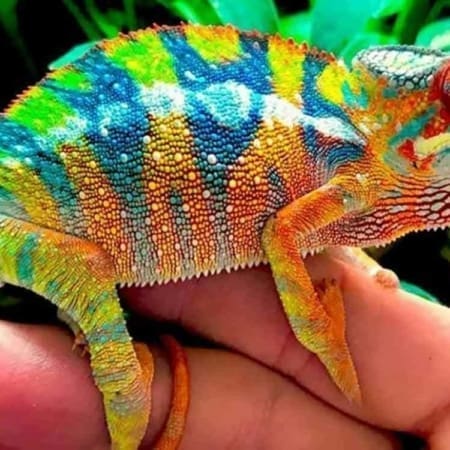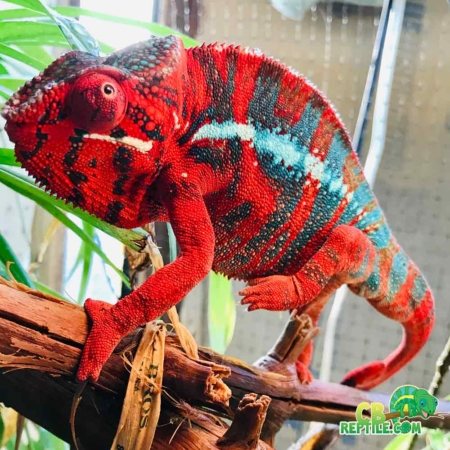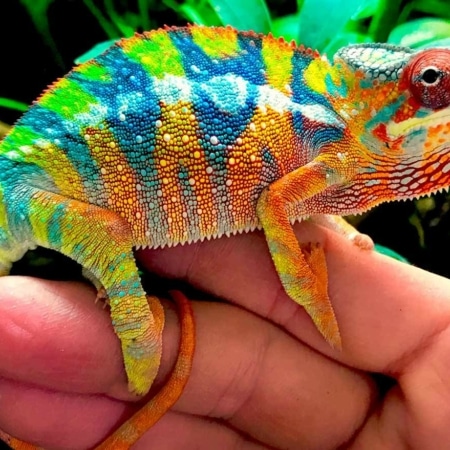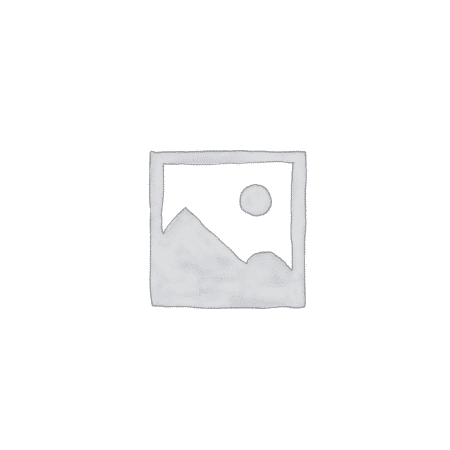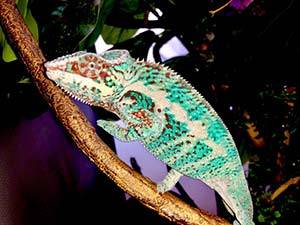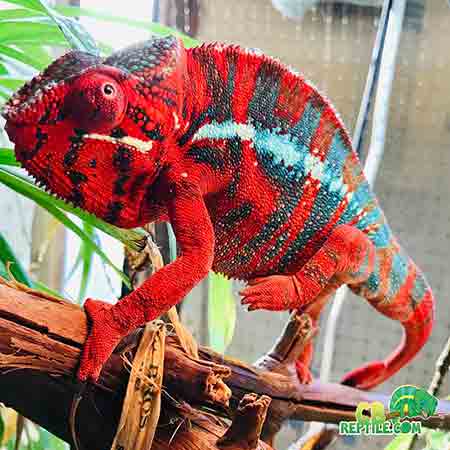Panther Chameleon Enclosure Setup & Environmental Design
Panther chameleons are arboreal reptiles that rely on height, foliage, branch structure, light gradients, and humidity balance to feel secure and thrive. A properly designed enclosure does far more than just “contain” the animal—it becomes a three-dimensional environment that supports natural behavior, stable hydration, correct thermoregulation, and confident movement. Whether you are preparing for your first baby panther chameleon or fine-tuning a long-term adult setup, thoughtful enclosure design is one of the single biggest factors in long-term health.
In the wild, panther chameleons live in forested habitats with layered canopies, filtered sunlight, and natural humidity cycles. The goal in captivity is not to replicate every detail of Madagascar, but to recreate the key environmental conditions that drive natural behaviors—climbing, basking, hunting, hiding, and resting in safe elevated perches.
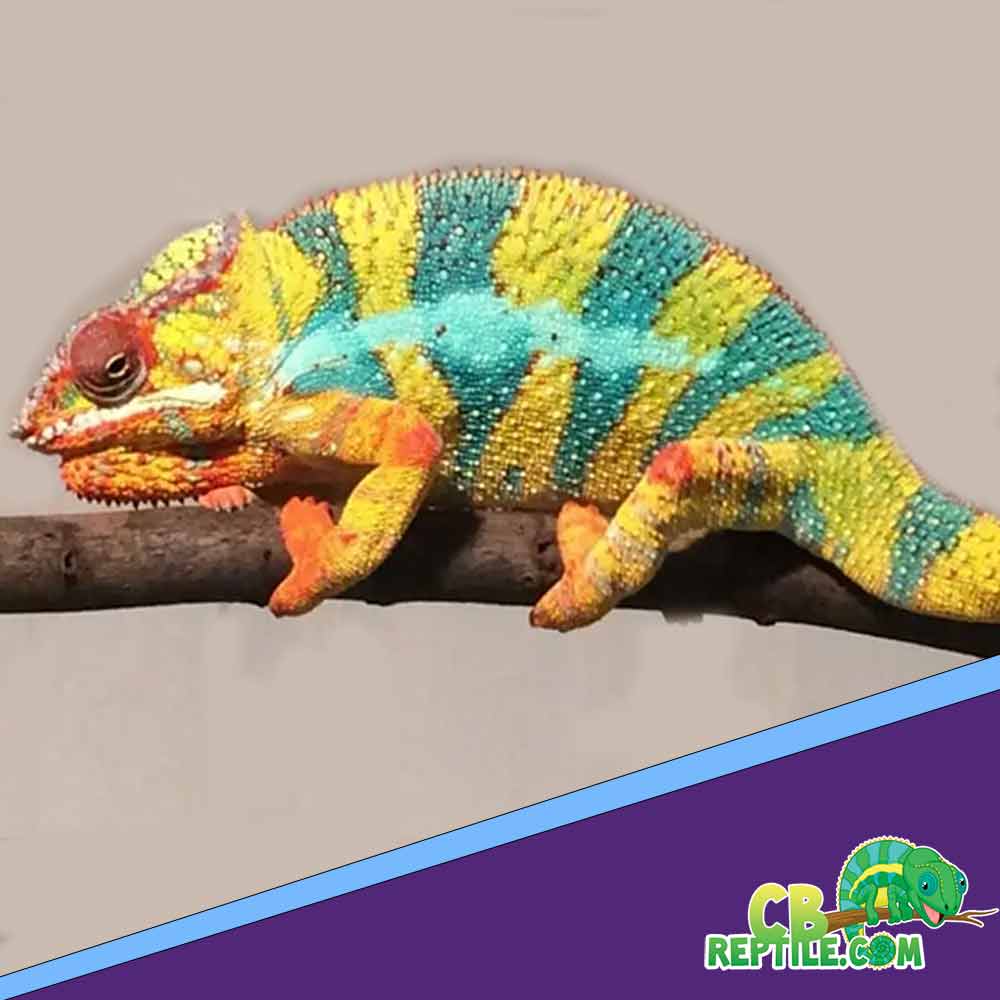
Choosing the Right Enclosure Size
Because panther chameleons are arboreal and highly visual, height and usable climbing space matter more than floor area alone. Vertical design supports their instinct to move up and down temperature gradients throughout the day.
Recommended Minimum Enclosure Sizes
- Young juveniles (0–4 months): 16 x 16 x 20–24 inches
- Growing juveniles (4–8 months): 18 x 18 x 24–30 inches
- Adults (8+ months): 24 x 24 x 48 inches or larger
Bigger is generally better as long as the enclosure is well furnished and chameleons can easily find food, basking spots, and hydration surfaces. Empty large cages with few branches or plants are more stressful than smaller, well-structured environments.
Screen, Hybrid, and Glass Enclosures
There is no single enclosure type that works in every home. The best choice depends on your local climate, indoor humidity, and ventilation needs.
Screen Enclosures
- Excellent airflow and ventilation
- Ideal in naturally humid climates
- Require more frequent misting to maintain humidity
Hybrid Enclosures
- Combination of solid sides and screened panels
- Help retain humidity while preventing stagnant air
- Often ideal for many indoor homes with moderate humidity
Glass Enclosures
- Can trap moisture and heat if not carefully ventilated
- Not ideal if airflow is poor
- Require special attention to prevent stagnant air and reflections
Most keepers raising a rapidly growing chameleons for sale line of panther locales find that screened or hybrid enclosures provide the best combination of airflow and humidity control.

Designing a Functional Vertical Layout
A panther chameleon enclosure is essentially a vertical playground. The goal is to create a network of branches, vines, and foliage that gives the chameleon choices: where to bask, where to hide, where to hunt, and where to cool down. Empty vertical space is wasted space, so think in layers.
Key Vertical Zones
- Upper basking zone: near heat and UVB
- Mid-level activity zone: for hunting, exploring, and resting
- Lower refuge zone: cooler, more humid, and heavily planted
By installing horizontal and diagonal branches at different heights, you create “roads” that your chameleon can use to travel safely and confidently through all these zones without having to climb on walls or screen.
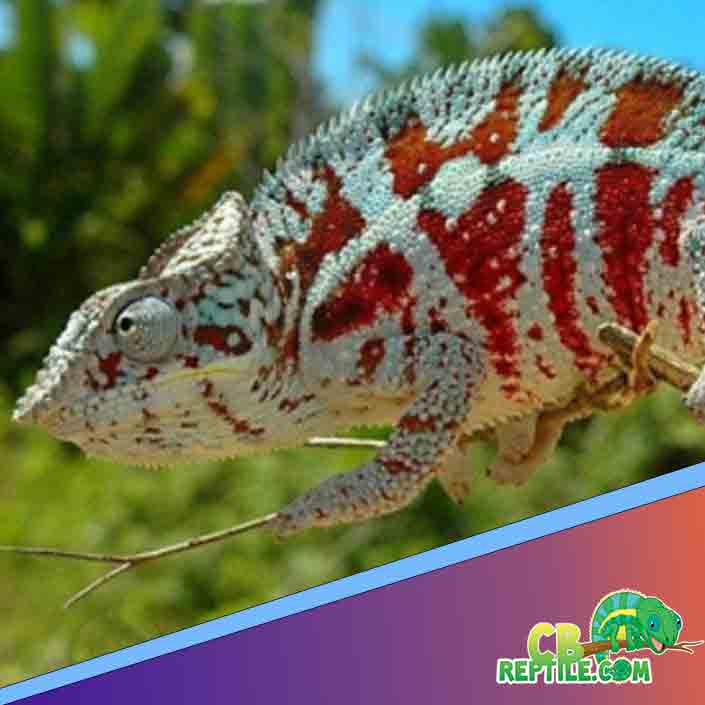
Branch & Perch Placement
Branches are the backbone of an arboreal setup. They provide secure grip, access to key environmental zones, and the elevated vantage points that panther chameleons prefer. Natural branches such as grapevine, manzanita, or securely cleaned hardwoods give better traction and a more natural aesthetic.
Branch Layout Tips
- Place at least one main horizontal branch 6–10 inches below the UVB and heat source for basking.
- Add multiple diagonal branches connecting upper, middle, and lower levels.
- Use thinner branches near foliage so the chameleon can easily navigate dense plants.
- Ensure branches are secure and do not wobble when the chameleon walks across them.
When designing for a newly acquired buy chameleon</a juvenile, use slightly thinner branches initially, then gradually incorporate thicker ones as the animal grows and its grip strength increases.

Using Live Plants for Coverage & Humidity
Live plants play two critical roles in a panther chameleon enclosure: they create visual barriers that reduce stress and they contribute to humidity and hydration. Leaves collect water droplets after misting, encouraging natural drinking behavior and providing a sense of security.
Popular Plant Choices
- Pothos: hardy, fast-growing, great for trailing cover
- Schefflera (umbrella plant): excellent mid- and upper-level foliage
- Ficus benjamina: tree-like structure for climbing and cover
- Dracaena: tall, structural plant with vertical leaves
Plants should be thoroughly washed, repotted in organic soil (no perlite, fertilizers, or pesticides), and placed so their root systems are protected from constant soaking. Arrange them so that there are dense clusters for hiding as well as open pathways for movement.

Lighting & UVB Positioning
Lighting drives the daily rhythm of panther chameleons. Proper UVB is essential for vitamin D3 synthesis and calcium metabolism, while visible light intensity influences behavior, appetite, and activity levels.
UVB Guidelines
- Use a T5HO linear UVB fixture (5.0 or 6% strength) across the top of the cage.
- Place the primary basking branch 8–12 inches below the UVB, depending on bulb strength and screen density.
- Ensure only part of the enclosure receives full UVB so the chameleon can choose between high and low exposure zones.
Visible Light & Plant Lighting
Pair UVB with a bright daylight or LED plant light to illuminate the entire enclosure. Panther chameleons are visual hunters; dim or poorly lit cages often lead to low activity and dull behavior.

Creating Temperature Gradients
Temperature gradients allow your chameleon to self-regulate body temperature throughout the day, just as they would in the wild. A single uniform temperature is unnatural and can cause chronic stress or overheating.
Target Temperature Ranges
- Basking spot: 84–88°F for adults, slightly lower for younger juveniles
- Mid-level ambient: 74–80°F
- Lower enclosure: 70–74°F
- Nighttime drop: 65–72°F (if your home allows it)
Adjust the wattage and distance of your basking bulb to achieve these ranges. Always verify temperatures with a reliable digital thermometer or temp gun.
Humidity & Hydration Zones
Panther chameleons do best with a balance between humidity and airflow. Too dry and they dehydrate; too wet with poor ventilation and respiratory issues can develop. A typical daytime humidity target is 50–70%, rising at night.
Hydration Strategy Inside the Enclosure
- Use a misting system or hand-mist 2–3 times per day.
- Perform a longer misting session in the morning to mimic dew.
- Use foliage-heavy areas to catch droplets for drinking.
- Optionally add a dripper over a plant for extended drinking opportunities.
Well-designed enclosures allow water to drain properly so the bottom does not become swampy. Elevating plants in pots and providing a drainage layer or tray helps maintain cleanliness.
Visual Barriers & Stress Reduction
Panther chameleons are solitary by nature. They feel more secure when they can move behind foliage or out of direct line-of-sight. Visual barriers created by plants, background panels, and side coverings significantly reduce stress and encourage natural behavior.
- Cover at least one or two sides of the enclosure with an opaque material or background.
- Use tall plants to break up direct views across the cage.
- Avoid placing the enclosure where there is constant foot traffic or where other pets stare into the cage.
A visually secure environment leads to better appetite, brighter coloration, and more confident basking behavior—especially in newly acquired youngsters that are still adjusting.
Placement of the Enclosure in the Room
Where you put the enclosure in your home matters as much as how you build it. Ideal placement is elevated, stable, and away from chaotic or drafty areas.
- Place the enclosure so the chameleon’s main perches are at or above your eye level.
- Avoid areas near vents, open doors, or loud speakers.
- Keep out of kitchens, laundry rooms, and other high-fume areas.
Stable environmental placement is especially important for a freshly shipped baby panther chameleon that is adjusting to a new home and learning to trust its surroundings.
Scaling the Enclosure as the Chameleon Grows
Panther chameleons grow quickly, particularly in the first 8–10 months. A small juvenile enclosure that works at the beginning will eventually feel cramped. Upgrading cage size and branch thickness over time prevents stunted behavior and encourages proper muscle development.
- Plan ahead to move juveniles into an adult-size cage around 7–9 months of age.
- Add thicker branches as the chameleon’s feet and body size increase.
- Rebuild foliage clusters to keep hiding zones intact even as branch layout changes.
Final Thoughts on Enclosure Design
A great panther chameleon enclosure is more than décor—it is a tool for health. When height, foliage, branch structure, lighting, UVB, heat gradients, humidity, and privacy are all aligned, chameleons exhibit natural, confident behavior. They explore, bask, hunt, rest, and hydrate in ways that mirror their wild instincts.
For keepers planning their first setup or expanding to additional locales, reviewing available chameleons for sale from experienced breeders and then tailoring the enclosure to the age and size of each individual is the smartest path to long-term success.
From the moment you decide to buy chameleon to the day it settles into its final enclosure, environmental design is the foundation that supports every other aspect of husbandry.

